Giovanni Battista Pittoni the Younger stands as one of the most significant and prolific painters of the Venetian School during the late Baroque and Rococo periods. Active primarily in Venice throughout the 18th century, Pittoni navigated the transition between artistic styles, ultimately becoming a leading exponent of the elegant and decorative Rococo. His vast output, encompassing religious, historical, and mythological subjects, earned him international acclaim and secured his position alongside other luminaries of the final great flourishing of Venetian painting. His work is characterized by its vibrant colour, dynamic compositions, and graceful figural representation, leaving an indelible mark on European art.
Early Life and Artistic Formation
Giovanni Battista Pittoni was born in Venice on June 6, 1687. His initial artistic training came under the tutelage of his uncle, Francesco Pittoni, also a painter, though of more modest reputation. While Francesco provided the foundational skills, the young Giovanni Battista quickly demonstrated a talent that would surpass his master's. Venice, at this time, was a vibrant artistic centre, and Pittoni was inevitably exposed to the prevailing currents and the works of established masters.
His early development shows a keen awareness of the leading figures who were shaping Venetian art at the turn of the century. The influence of Sebastiano Ricci, with his luminous palette and dynamic, painterly approach, is palpable in Pittoni's formative works. Ricci's own synthesis of Venetian colour and broader European Baroque trends provided a crucial model. Equally important was the towering figure of Giovanni Battista Tiepolo, whose grand-scale decorative schemes and mastery of light and aerial perspective set a high bar for contemporaries. Antonio Balestra, known for a more classical and restrained style compared to Ricci or Tiepolo, also appears to have informed Pittoni's sense of composition and draughtsmanship during his early years.
The Emergence of a Rococo Sensibility
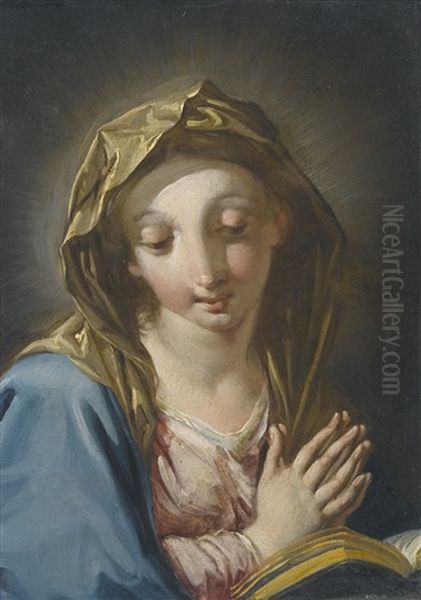
Pittoni formally entered the Venetian artistic community by joining the Fraglia dei Pittori, the city's guild of painters, in 1716. This marked the beginning of a long and successful professional career. An early significant commission, the Martyrdom of St. Thomas (circa 1722-1723) for the Church of San Stae in Venice, already showcases his ability to handle large-scale, dramatic narratives, clearly reflecting the influence of Ricci and the burgeoning energy associated with Tiepolo.
However, Pittoni soon began to forge his own distinct artistic identity. While absorbing the lessons of the late Baroque, he increasingly gravitated towards the lighter, more elegant, and sensuous aesthetic of the Rococo. This style, originating in France with artists like Antoine Watteau and François Boucher, found fertile ground in Venice. Pittoni became one of its most accomplished interpreters, blending French grace with the rich colouristic tradition of his native city. His brushwork became more fluid and feathery, his palette brightened, favouring pastel hues alongside vibrant accents, and his compositions often adopted swirling, asymmetrical arrangements.
Mature Style: Elegance and Emotion
Throughout the 1720s and 1730s, Pittoni produced a remarkable number of works that epitomize the Venetian Rococo. His paintings from this period are characterized by their refined elegance, delicate beauty, and sophisticated handling of light and colour. Figures are typically graceful, elongated, and posed with theatrical flair, conveying emotion through gesture and expression. He excelled at creating complex multi-figure compositions that remain clear and legible, guiding the viewer's eye through intricate arrangements.
His colour palette is particularly noteworthy, often featuring silvery blues, rose pinks, pale yellows, and soft greens, illuminated by a bright, diffused light. This contrasts with the more dramatic chiaroscuro favoured by earlier Baroque masters like Giovanni Battista Piazzetta, another influential contemporary whose more tenebrist style represented a different facet of Venetian painting. Pittoni's approach emphasized decorative harmony and visual pleasure, perfectly suited to the tastes of the era.
Religious Themes
Religious subjects formed a significant portion of Pittoni's oeuvre. He produced numerous altarpieces for churches in Venice and beyond, as well as smaller devotional paintings for private patrons. His interpretations often emphasize the pathos and divine grace inherent in the narratives. Works like the Annunciation (examples in the Gallerie dell'Accademia, Venice, and elsewhere) showcase his ability to infuse traditional themes with Rococo elegance, depicting the Virgin Mary and the Archangel Gabriel with delicate sensitivity amidst ethereal light and colour.
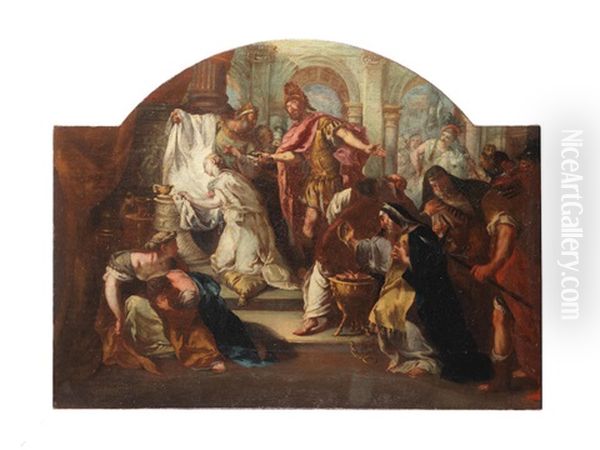
His depictions of martyrdoms, such as the aforementioned Martyrdom of St. Thomas or the Martyrdom of St. Paul, manage to convey the drama and suffering of the events without sacrificing aesthetic refinement. The Sacrifice of Jephthah's Daughter is another powerful example, capturing the tragic moment with emotional intensity rendered through graceful forms and a rich, though controlled, palette. He also painted numerous variations of the Madonna and Child, often accompanied by saints, demonstrating a tender and approachable vision of the divine. The Madonna and Child with Saints Leonard and Francis of Paola and Souls in Purgatory exemplifies his skill in complex altarpiece design.
Mythological and Historical Narratives
Alongside religious commissions, Pittoni excelled in mythological and historical subjects, which allowed for displays of erudition and decorative invention. These themes were popular among aristocratic patrons across Europe. His mythological paintings often depict scenes from Ovid's Metamorphoses or other classical tales, featuring gods, goddesses, and heroes rendered with characteristic Rococo charm and sensuality.
Historical subjects provided opportunities for grand compositions and explorations of virtue, sacrifice, or clemency. The Sacrifice of Polyxena, depicting the tragic Trojan princess, showcases his ability to handle complex narratives with emotional depth and compositional skill. Another notable example is The Continence of Scipio, a subject illustrating Roman virtue, which he painted for one of his most important patrons, Marshal Johann Matthias von der Schulenburg. These works demonstrate Pittoni's engagement with classical antiquity, albeit interpreted through the fashionable lens of the 18th century.
Major Commissions and International Patronage
Pittoni's reputation extended far beyond Venice. He received significant commissions from patrons and collectors across Europe, particularly in Germany, Austria, Poland, and Russia. His work for Marshal von der Schulenburg, a discerning collector and former general in the Venetian service, is well-documented and includes several key paintings. He also contributed works to the decoration of palaces, such as those belonging to the Schönborn family in Germany.
His success in securing international commissions highlights the widespread appeal of the Venetian Rococo style and Pittoni's prominent position within it. Churches like San Giorgio Maggiore in Venice also housed his altarpieces, cementing his status within his home city. This international dimension distinguishes Pittoni and underscores Venice's role as a major exporter of artistic talent and style during this period, rivalled perhaps only by Paris. His ability to satisfy diverse patrons speaks to the adaptability and broad appeal of his elegant art.
Role in the Venetian Academy
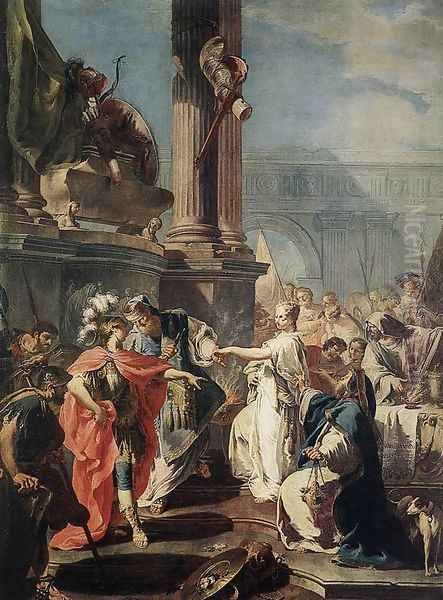
Beyond his prolific output as a painter, Pittoni played a crucial institutional role in the Venetian art world. He was a co-founder of the Accademia di Belle Arti di Venezia (Venice Academy of Fine Arts) in 1750, an institution established to promote the arts and provide formal training for young artists. This initiative aimed to uphold the standards and prestige of Venetian painting in a changing Europe.
His commitment to the Academy and his standing among his peers were confirmed when, in 1758, he was elected President of the institution, succeeding the great Tiepolo who had departed for Spain. Pittoni held this prestigious position until 1760 or 1761, guiding the Academy during its formative years. His leadership role underscores his importance not just as a creator but also as an influential figure shaping the future direction of Venetian art education.
Draughtsmanship
Pittoni was also a highly accomplished draughtsman. Numerous preparatory drawings for his paintings survive, executed primarily in black and white chalk on coloured paper, often blue. These drawings reveal his working process, showcasing his skill in capturing poses, arranging figures, and studying light effects. They possess a spontaneity and fluidity that complements the elegance of his finished paintings. Often squared for transfer, these drawings are not merely functional studies but possess an intrinsic artistic quality, valued by collectors in their own right. His facility as a draughtsman underpinned the complex compositions and graceful figures that characterize his painted work.
Later Years and Stylistic Evolution
In the later decades of his career, Pittoni's style continued to evolve, though subtly. Some scholars detect a shift towards slightly more subdued colours and calmer compositions compared to the exuberant peak of his Rococo phase. There might be a greater emphasis on sentiment and a quieter emotional tone in some of his late religious works. However, he remained highly productive and sought after until the end of his life.
His fundamental commitment to elegance, refined colour, and graceful composition remained consistent. He continued to receive commissions and maintained his prominent position in the Venetian art scene. His long career spanned a period of significant change, witnessing the height of the Rococo and the stirrings of Neoclassicism, though his own style remained firmly rooted in the late Baroque and Rococo traditions he had mastered.
Contemporaries and the Venetian Milieu
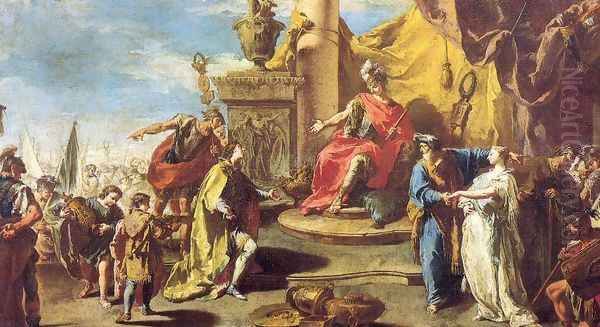
Pittoni worked within a rich artistic environment. His relationship with Sebastiano Ricci and Giovanni Battista Tiepolo was foundational, marked by influence and mutual respect within the competitive Venetian scene. He was also contemporary with Giovanni Battista Piazzetta, whose darker, more naturalistic style offered a contrast, yet both were key figures. Antonio Canaletto and Bernardo Bellotto were achieving fame with their detailed vedute (view paintings), catering to the Grand Tour market. Rosalba Carriera gained international renown for her exquisite pastel portraits.
Pietro Longhi documented Venetian life in his intimate genre scenes, while Francesco Guardi would later capture the city's atmosphere with flickering, evocative brushwork. Pittoni also collaborated occasionally with specialists, such as the quadratura painter Gerolamo Mengozzi Colonna, who created illusionistic architectural settings (though Colonna is more famously associated with Tiepolo). Pittoni's interaction with Nicola Grassi, another Rococo painter, is also noted, despite stylistic differences, indicating the collaborative and interconnected nature of the Venetian art world. His work shows an awareness of French Rococo, perhaps indirectly through Ricci or directly via prints, aligning him with trends associated with Watteau, Boucher, and Jean-Honoré Fragonard, even if his Venetian identity remained paramount.
Students and Legacy
While Pittoni ran an active studio, specific documentation of all his pupils is scarce. One notable student or assistant was Anton Kern, a Bohemian painter who absorbed Pittoni's style and helped disseminate it in Central Europe after returning to Prague. Pittoni's influence extended more broadly through his numerous commissioned works sent abroad, impacting artistic taste in Germany, Austria, and Poland.
His legacy lies in his role as a principal figure of the Venetian Rococo. He successfully synthesized Venetian colour traditions with the elegance and lightness of the international Rococo style. His prolific output, technical brilliance, and influential position as Academy president solidified his importance. While perhaps overshadowed in popular imagination by Tiepolo or Canaletto, Pittoni remains a crucial figure for understanding the richness and diversity of 18th-century Venetian painting. His works continue to be admired in major museums worldwide for their decorative beauty, emotional resonance, and technical mastery.
Art Historical Perspectives and Discussion Points
Art historians continue to discuss various aspects of Pittoni's career. The precise nature and extent of French Rococo influence versus native Venetian development in his style remain points of analysis. His ability to blend seemingly disparate elements – the grand manner of history painting with the intimate charm of the Rococo – is a testament to his skill.
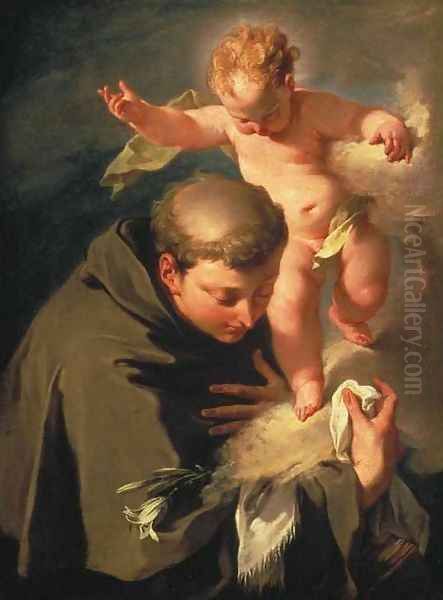
The "controversy" or discussion regarding his reliance on established religious and historical themes, sometimes seen as less innovative than the genre scenes of Longhi or the vedute of Canaletto, reflects differing perspectives on artistic merit and originality. However, his mastery within these traditional genres is undeniable. His international success also raises questions about artistic identity – was he primarily a Venetian painter, or a more "global" artist catering to pan-European tastes? Ultimately, these discussions enrich our understanding of Pittoni as a complex figure operating within a dynamic and cosmopolitan art world. His preference for classical and religious themes over scenes of contemporary Venetian life is also noted, perhaps reflecting the demands of his patrons or his own artistic inclinations towards grander narratives.
Conclusion
Giovanni Battista Pittoni died in Venice on November 20, 1767, at the age of 80, leaving behind a vast and impressive body of work. He was a pivotal figure in 18th-century Venetian art, a master technician whose paintings epitomize the grace, elegance, and luminous colour of the Rococo era. From his early training under his uncle Francesco to his mature works influenced by Ricci and Tiepolo, and his later role as President of the Venice Academy, Pittoni navigated his long career with skill and success. His religious, mythological, and historical paintings, found in churches and museums across Europe, stand as enduring testaments to the final, brilliant chapter of the Venetian School. He remains celebrated for his sophisticated compositions, delicate figural style, and masterful handling of light and colour, securing his place as a key protagonist of European Rococo painting.